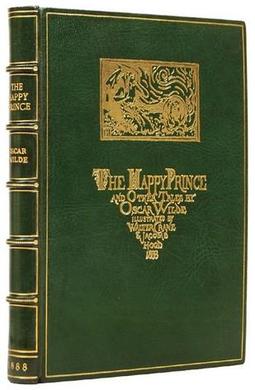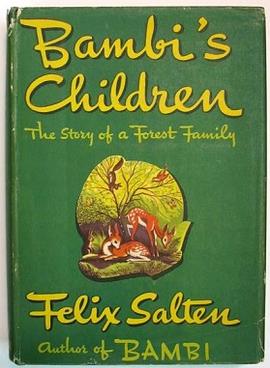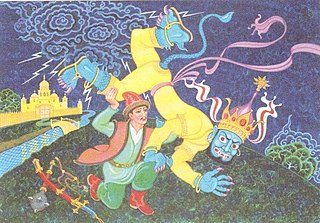
Branwen, Daughter of Llŷr is a major character in the Second Branch of the Mabinogi, which is sometimes called the "Mabinogi of Branwen" after her.

Aloysius Snuffleupagus, more commonly known as Mr. Snuffleupagus or Snuffy for short, is one of the characters on Sesame Street, a long-running PBS/HBO educational television program for young children. He is a giant anteater-like elephant-creature, without tusks or (visible) ears, and has a long thick pointed tail, similar in shape to that of a dinosaur or other reptile. He has long thick brown, feathery hair and a trunk, or "snuffle", that sometimes drags along the ground. He is Big Bird's best friend and has a younger sister named Alice. He also attends "Snufflegarden".

The BFG is a 1982 children's book written by British novelist Roald Dahl and illustrated by Quentin Blake. It is an expansion of a short story from Dahl's 1975 book Danny, the Champion of the World. The book is dedicated to Dahl's late daughter, Olivia, who died of measles encephalitis at the age of seven in 1962.

The Happy Prince and Other Tales is a collection of stories for children by Oscar Wilde first published in May 1888. It contains five stories: "The Happy Prince", "The Nightingale and the Rose", "The Selfish Giant", "The Devoted Friend", and "The Remarkable Rocket". in 2003, the second through fourth stories were adapted by Lupus Films and Terraglyph Interactive Studios into the three-part series Wilde Stories for Channel 4.

"Rapunzel" is a European fairy tale most notably recorded by the Brothers Grimm and published in 1812 as part of Children's and Household Tales. The Brothers Grimm's story was developed from the French literary fairy tale of Persinette by Charlotte-Rose de Caumont de La Force (1698).

Wild Swans: Three Daughters of China is a family history that spans a century, recounting the lives of three female generations in China, by Chinese writer Jung Chang. First published in 1991, Wild Swans contains the biographies of her grandmother and her mother, then finally her own autobiography. Her grandmother had bound feet and was married off at a young age as the concubine of a high-status warlord. Chang's mother rose in status as a member of the Communist Party. Chang took part in the Cultural Revolution as a member of the Red Guards, but eventually her father was tortured and she was sent to the countryside for thought reform. Later, she earned a scholarship to study in England, where she still lives.

"The Three Ravens" is an English folk ballad, printed in the song book Melismata compiled by Thomas Ravenscroft and published in 1611, but it is perhaps older than that. Newer versions were recorded right up through the 19th century. Francis James Child recorded several versions in his Child Ballads.

The Spiderwick Chronicles is a series of children's fantasy books by Tony DiTerlizzi and Holly Black. They chronicle the adventures of the Grace children, twins Simon and Jared and their older sister Mallory, after they move into the Spiderwick Estate and discover a world of fairies that they never knew existed. The first book, The Field Guide, was published in 2003 and then followed by The Seeing Stone (2003), Lucinda's Secret (2003), The Ironwood Tree (2004), and The Wrath of Mulgarath (2004). Several companion books have been published including Arthur Spiderwick's Field Guide to the Fantastical World Around You (2005), Notebook for Fantastical Observations (2005), and Care and Feeding of Sprites (2006). A second series, entitled Beyond the Spiderwick Chronicles, includes The Nixie's Song (2007), A Giant Problem (2008), and The Wyrm King (2009).

The swan maiden is a mythical creature who shapeshifts from human form to swan form. The key to the transformation is usually a swan skin, or a garment with swan feathers attached. In folktales of this type, the male character spies the maiden, typically by some body of water, then snatches away the feather garment, which prevents her from flying away, forcing her to become his wife.

Melanesian mythology refers to the folklore, myths, and religions of Melanesia, a region in Southwest Oceania that encompasses the archipelagos of New Guinea, the Torres Strait Islands, Solomon Islands, Vanuatu, New Caledonia and Fiji.

The King of England and his Three Sons is a Romani fairy tale collected by Joseph Jacobs in More English Fairy Tales. He listed as his source Francis Hindes Groome's In Gypsy Tents, where the informant was John Roberts, a Welsh Roma. Groome published the tale as An Old King and his three Sons in England.

Bambi's Children: The Story of a Forest Family is a 1939 coming-of-age novel written by Austrian author Felix Salten as a sequel to his 1923 work Bambi, a Life in the Woods.

The black swan is widely referenced in Australian culture, although the character of that importance historically diverges between the prosaic in the east and the symbolic in the west. The black swan is also of spiritual significance in the traditional histories of many Aboriginal Australian peoples across southern Australia. Metaphoric references to black swans have appeared in European culture since long before Europeans became aware of Cygnus atratus in Australia in the 18th century.

Ural-batyr or Ural-batır is the most famous kubair of the Bashkirs. It is a telling of heroic deeds and legendary creatures, the formation of natural phenomena, and so on.
Loka Táttur or Lokka Táttur is a Faroese ballad which is an example of the occurrence of Norse gods in folklore.
"Save Henry" is the ninth episode of the third season of the American fantasy drama series Once Upon a Time, and the show's 53rd episode overall.

The Sea Tsar and Vasilisa the Wise is a Russian fairy tale published by author Alexander Afanasyev in his collection of Russian Fairy Tales, numbered 219. The tale features legendary characters Tsar Morskoi and Vasilisa the Wise.
The Goose Wife is a mythical female character that appears in tales from the Inuit and other ethnic groups that dwell across the circumpolar Arctic region. The usual story is that the geese alight on land, become women by taking off their goose-skins and bathe in a lake. However, they are unaware that a human hunter is spying on them, and he steals the goose-skin of one of them, forcing her to be his wife. Due to the great similarities between both characters, the goose wife has been compared to the swan maiden, another female that alternates between human and bird forms.
The Swan Queen is a Lithuanian fairy tale related to the character of the swan maiden. In the tale, a peasant couple find a swan or goose and bring it home, which transforms into a human girl they adopt as their daughter. After her birdskin is destroyed and she marries a human prince, her bird flock gives her a new set of garments and she turns back into a bird.
The Beautiful Palace East of the Sun and North of the Earth is a Swedish folktale collected from Smaland by Swedish folktale collectors George Stephens and Gunnar Olof Hyltén-Cavallius. It features versions of the swan maiden, a mythic female character that alternates between human and animal shapes.















